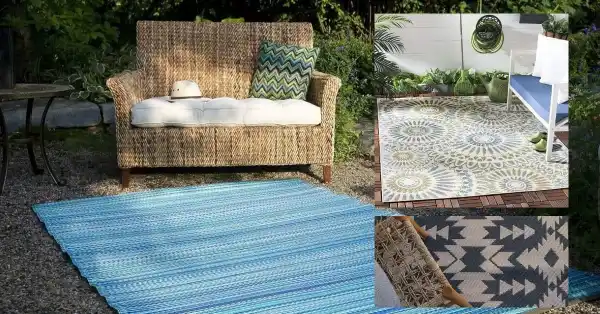What to Consider When Choosing a Rug for Your Patio
When it comes to designing your outdoor living spaces, there are several factors to consider in choosing the right rug for your patio. Here are some things to keep in mind before making your purchase:
1. Size: One of the most important things to consider when choosing a rug for your patio is the size. The size of the rug should be proportional to the size of your patio or outdoor area. If you have a large patio with a dining table and chairs, then you may want to opt for a larger, rectangular rug to cover the entire seating area. On the other hand, if you have a petite balcony with just a single chair and small table, a smaller, round or square rug may be a better choice.
2. Material: The material of the rug is also important to consider when choosing the perfect rug for your patio. Look for materials that are designed to withstand outdoor elements such as rain, sun, and dirt. Synthetic materials such as polypropylene fiber or synthetic fibers are often used for outdoor rugs because they can withstand the elements and are easy to clean. An outdoor rug on a concrete patio can provide a layer of protection for your patio surface, add a splash of color to your space, and create a comfortable and inviting atmosphere for outdoor gatherings.
3. Style: The style of your rug can also enhance the overall look of your patio. Geometric patterns are a popular choice for outdoor rugs, as they can add a pop of color and design to your space. Natural materials such as sisal or jute are also popular choices for more organic and earthy looks.
4. Furniture Layout: Consider the placement of your outdoor dining table and chairs, as well as any additional seating arrangement you may have. The rug should be placed in a way that complements the furniture layout and doesn’t interfere with the functionality of the space.
5. Budget: Outdoor rugs come in a range of prices, so it is important to consider your budget when choosing a rug for your patio. Look for affordable options that still offer durability and style.
In conclusion, choosing the right rug for your patio takes careful consideration of the size, material, style, furniture layout, and budget. By weighing these factors, you can create a comfortable and inviting outdoor living space that is perfect for relaxation and entertaining.
Benefits of Outdoor Area Rugs
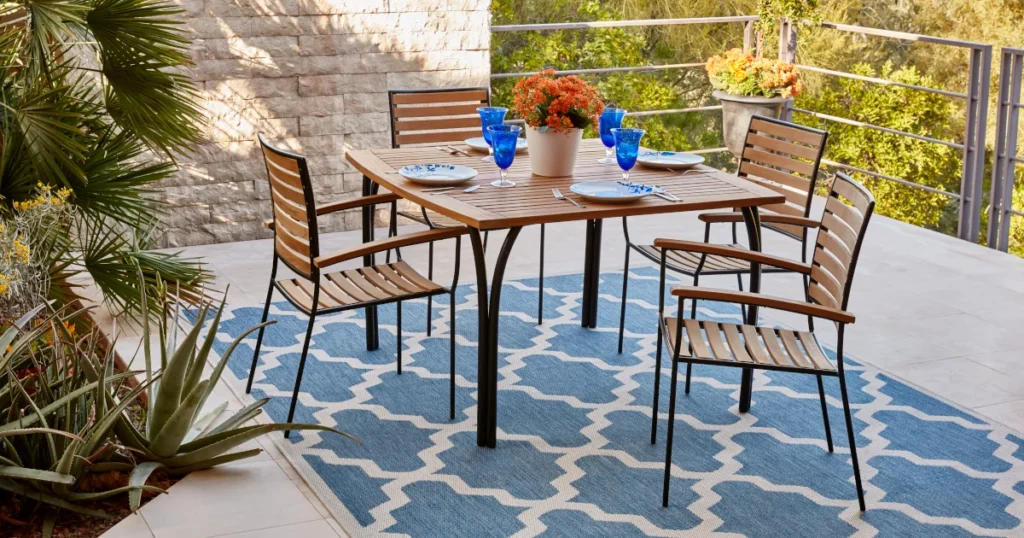
Outdoor area rugs can be a game changer for your outdoor living space. These versatile and functional pieces can offer many benefits that can take your outdoor decor to the next level. Here are some of the major benefits of incorporating an outdoor area rug in your outdoor living space:
1. Adds Comfort: Outdoor area rugs are designed to add an extra layer of comfort for your outdoor seating area. These rugs can be made from synthetic or natural materials like sisal, jute, or polypropylene fibers that can resist moisture and sun damage. This means that you can enjoy a soft and comfortable surface underfoot while lounging outside without worrying about damage or wear and tear.
2. Enhances the Look: Outdoor area rugs come in a variety of styles and designs that can enhance the look of your outdoor space. From geometric patterns to natural textures, there’s a style to suit any taste, and with the perfect placement, an outdoor area rug can become the centrepiece of your outdoor decor.
3. Defines Space: If you have a sprawling outdoor space, adding an area rug can help to define specific areas, such as an outdoor seating area or dining space. By selecting the right size and shape, you can create a visual separation between different areas, helping to create a more organized and cohesive space.
4. Protects Surfaces: Outdoor area rugs can also help to protect your surfaces, such as patios or decking, from damage. They can absorb moisture, dirt, and other debris that may come in contact with your outdoor furniture, preserving your surfaces over time, and keeping them clean and protected.
5. Easy to Clean: Outdoor area rugs are designed to be low maintenance. Most can be cleaned with a simple hose down, and are resistant to mold and mildew. This makes them perfect for outdoor living spaces that are exposed to the elements.
In conclusion, an outdoor area rug is a functional yet stylish addition to any outdoor living space. From adding comfort to enhancing the look, defining space, protecting surfaces, and being easy to clean, it’s easy to see why outdoor area rugs are a must-have for any outdoor decor enthusiast.
Size Considerations
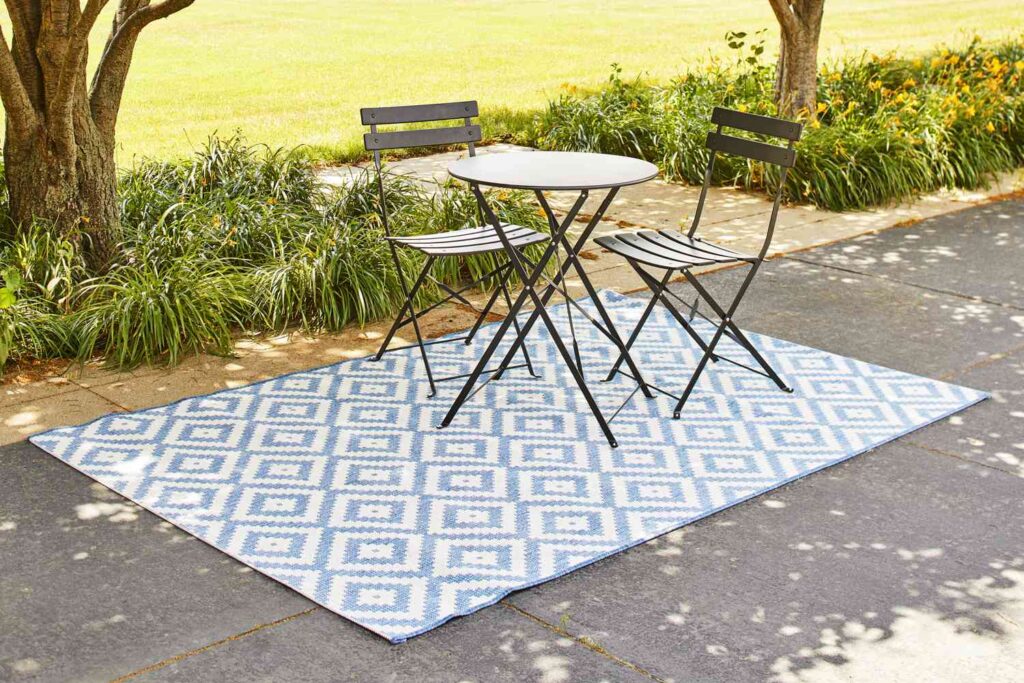
When it comes to selecting an outdoor area rug, size is an important consideration. Choosing the right size rug for your patio or outdoor space can make all the difference in terms of comfort and style. Here are some factors to keep in mind when selecting the perfect size outdoor rug for your space.
Firstly, it’s important to consider the square footage of your outdoor space. A large outdoor space may require a larger rug to help define the space, while a smaller space may only need a petite outdoor rug to add some comfort and style. Before you start shopping, take some measurements of your outdoor area to help determine the ideal size rug.
The furniture layout of your outdoor space is another important factor to consider when sizing your outdoor rug. For example, if you have an outdoor dining table, you’ll want to choose a rug that is large enough to accommodate the table and chairs, with some extra space around the edges. On the other hand, if you have a seating arrangement with a coffee table and pair of chairs, a smaller rug may be more appropriate.
When it comes to the shape of your outdoor rug, this will generally depend on the shape of your outdoor furniture. A square or rectangular rug is ideal for a square or rectangular dining table, while a round rug can complement a round table or seating arrangement.
Finally, consider the overall style of your outdoor space when selecting an outdoor area rug. A geometric patterned rug may complement a modern decor style, while a natural fiber rug may enhance a more bohemian or rustic vibe.
In summary, when selecting the perfect size outdoor rug for your patio or outdoor space, consider the square footage, furniture layout, shape, and overall style of your space. By keeping these factors in mind, you can choose an outdoor rug that adds both comfort and style to your outdoor living space.
Measurements
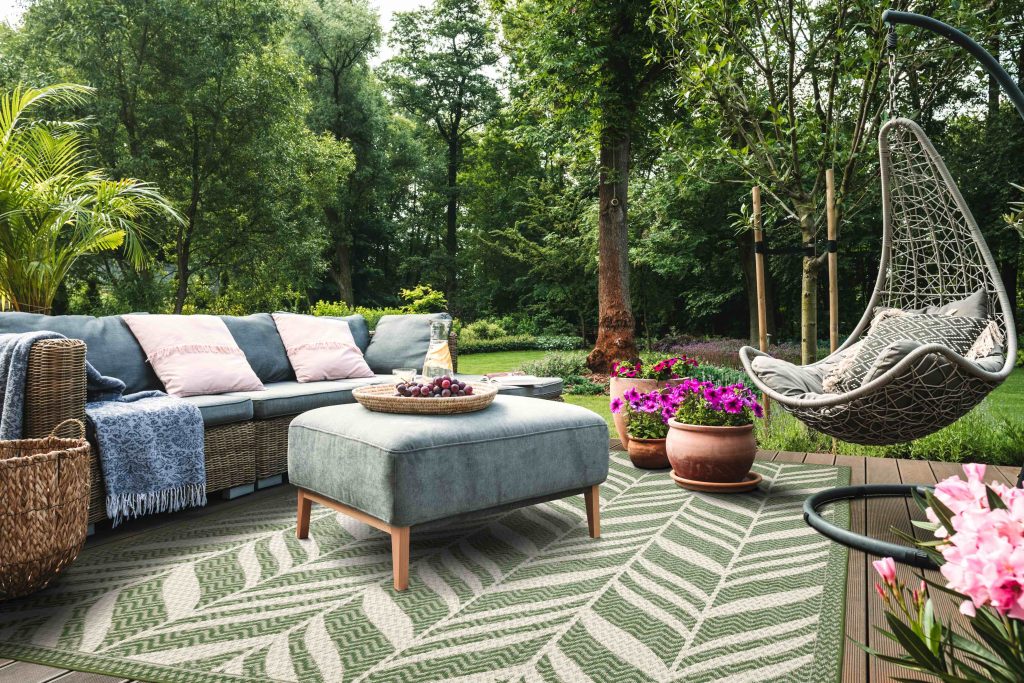
When it comes to buying the perfect rug for your space, understanding measurements is crucial. Making the right measurements can make all the difference between a rug that fits perfectly and one that looks awkward and out of place.
The first step is to decide the area you want to place the rug in. Measure the space either with a measuring tape or by marking the floor with chalk. If you have a square or rectangular space, determine the length and width of the area. For example, if you are placing the rug underneath a dining table, include the chairs in your measurements to ensure that everyone will have enough sitting space. If you have a larger room, you may need to consider dividing the space into smaller sections and measuring them individually to determine the right size rug.
Once you have your measurements, it’s time to consider the size of the rug. If you are placing the rug in a smaller space, consider choosing a runner rug as it will complement the area without overwhelming it. If you are placing the rug in a larger space, choose a larger area rug that still leaves enough space on the edges of the room. A common rule of thumb is to leave about 18 inches of space between the rug and the wall.
If you are placing the rug in an outdoor area, take into account the furniture layout in relation to the size of the rug. For instance, if you have a larger patio, consider a large-sized outdoor rug that can accommodate the dining table and chairs, and around 24 inches of the extra area around the furniture.
While measuring the space and choosing the ideal size of your rug is important, keep in mind that the rug’s thickness and material will also affect its look. Consider the type of material that will suit your needs best, such as sisal, outdoor carpet, or a synthetic fiber for outdoor use, or woolen or silk fibers for your indoor spaces. Each material has different upkeep needs and durability, meaning synthetic rugs may be more rain-resistant whereas natural fiber rugs may not be mildew-resistant.
Taking time to make accurate measurements will help you choose the right rug for your space, enhance the room’s look, and add a layer of comfort to space.
Square Footage Calculations

When it comes to determining the square footage of a room or space, it’s important to use accurate measurements to ensure you purchase the right amount of flooring or paint, or to properly plan the layout of your furniture. Square footage calculations are a useful tool for homeowners, contractors, and interior designers alike.
To calculate the square footage of a rectangular room, simply measure the length and width of the space and multiply them together. For example, if a room is 10 feet wide and 15 feet long, the square footage is 150 square feet (10×15=150). However, not all rooms are perfect rectangles.
To calculate the square footage of an irregularly shaped room, you can break down the space into smaller rectangles or squares and add them together. Start by measuring the length and width of each individual section and multiply them together to find the square footage of that section. Then, add up the square footage of each section to determine the total square footage of the room.
It’s also important to consider any obstructions that may affect the square footage calculations, such as an inset fireplace, bay window, or built-in bookshelf. Measure the length and width of each obstruction separately and subtract it from the overall square footage calculation.
When calculating square footage, it’s important to account for any hallways or doorways that lead to the room. Measure the length and width of the hallway or doorway and subtract it from the square footage calculation of the room itself.
Another consideration when calculating square footage is the space between individual pieces of furniture. If there is a large gap between two pieces of furniture, it may be beneficial to exclude that area from the total square footage calculation.
Overall, accurate square footage calculations are essential for any project that involves planning the layout of a space or purchasing materials for a room. By following these tips and taking careful measurements, you can ensure that your calculations are precise and reliable.
Perfect Size Options for Small Patios
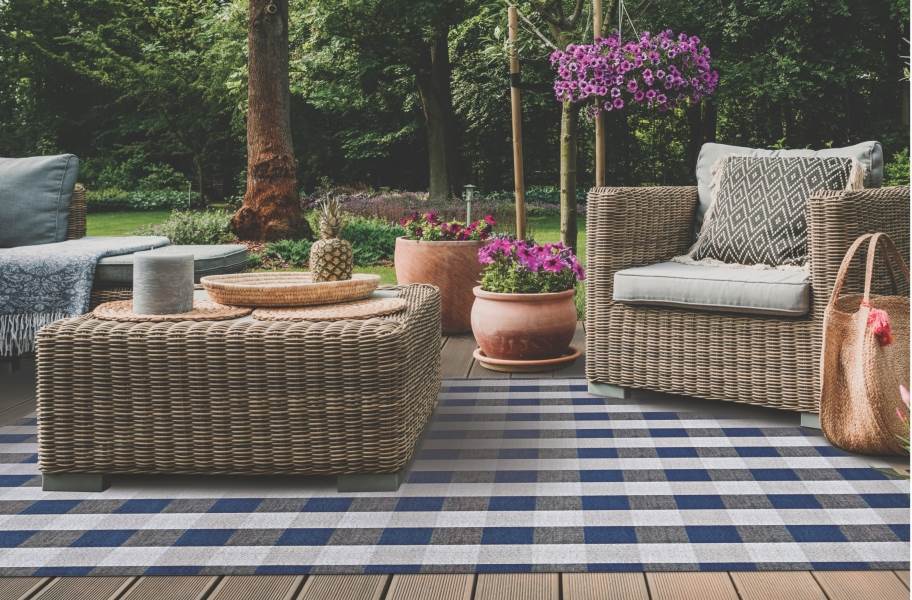
Small patios present a unique challenge when it comes to choosing a rug size. You want to make sure the space feels cozy and put together, but don’t want the rug to overwhelm the area. Luckily, there are plenty of perfect size options for small patios that will enhance the look and feel of the space.
For petite spaces, a 5′ x 7′ rug is a great starting point. This is a common rug size that is versatile and can fit a variety of outdoor seating arrangements. Pairing a 5′ x 7′ rug with a small outdoor dining table and chairs or a cozy seating area with a loveseat and accent chairs will create a beautiful and functional patio space.
If your small patio is a narrow balcony or a smaller deck area, consider a runner rug that will fit perfectly in the space. A runner rug is a long, narrow rug that can be used to define the area and add interest and texture to the space.
Square tables are a popular choice for outdoor dining, and a 6′ x 6′ rug will fit perfectly underneath. This size rug will accommodate a table and four chairs comfortably, creating a cozy and intimate outdoor dining experience.
For rectangular dining tables, a rectangular rug that is slightly larger than the table is a great option. A 5′ x 8′ rug is a common size that will fit perfectly under a standard size outdoor dining table. This will create a defined space for dining and add visual interest to the patio.
When choosing a rug for a small patio, it’s important to consider the materials as well. Natural fiber rugs such as sisal or jute are great options for outdoor spaces as they are durable and easy to clean. Synthetic materials such as polypropylene are also a great choice as they are mildew resistant and can withstand harsh weather conditions.
In conclusion, there are many perfect size options for small patios that will enhance the look and feel of the space. By choosing the right size rug and materials, you can create a cozy and functional outdoor living area that you will enjoy for years to come.
Rug Sizes to Accommodate Larger Spaces
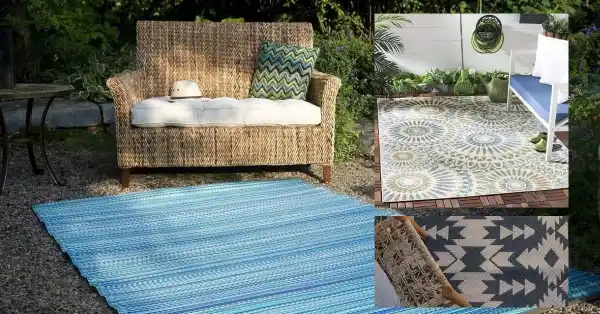
If you have a larger outdoor space, the right rug can tie the area together and create a cozy atmosphere. But with so much room to work with, what size rug should you choose? Here are some tips for selecting a rug size for a larger outdoor space:
Consider the Square Footage
First and foremost, you’ll want to take measurements of your outdoor space. Knowing the exact square footage will help you determine what size rug will best fit. If you have a spacious patio or deck, a larger rug can be a great way to anchor your furniture and create defined zones within the space.
Go Big or Go Home
When it comes to larger outdoor spaces, it’s better to choose a rug that is too big rather than too small. A rug that is too small can make the area feel disjointed and unbalanced. A larger rug will create a cohesive look and make the area feel more welcoming.
Choose the Right Shape
Rectangular rugs are the most popular option for outdoor spaces, but circular rugs can also be a great choice for larger areas. A circular rug can create a focal point in the center of the space and add visual interest to an otherwise flat area.
Coordinate with Your Furniture
The size of your furniture should also be taken into consideration when selecting a rug size. For example, if you have a large outdoor sectional, a rug that is at least 9′ x 12′ will comfortably accommodate the furniture and create a cozy seating area.
Invest in Quality Materials
Natural fiber rugs such as sisal, jute, and bamboo are durable and can withstand the elements, making them an excellent choice for larger outdoor spaces. Synthetic fiber rugs made from polypropylene or other materials are also a great option as they are weather-resistant and easy to clean.
In summary, selecting a rug size for a larger outdoor space can seem daunting, but by taking accurate measurements and considering your furniture, you can find the right size and shape to create a welcoming and cohesive atmosphere in your outdoor living space. Remember to invest in high-quality materials to ensure your rug can withstand the elements and last for years to come.
Material Selection
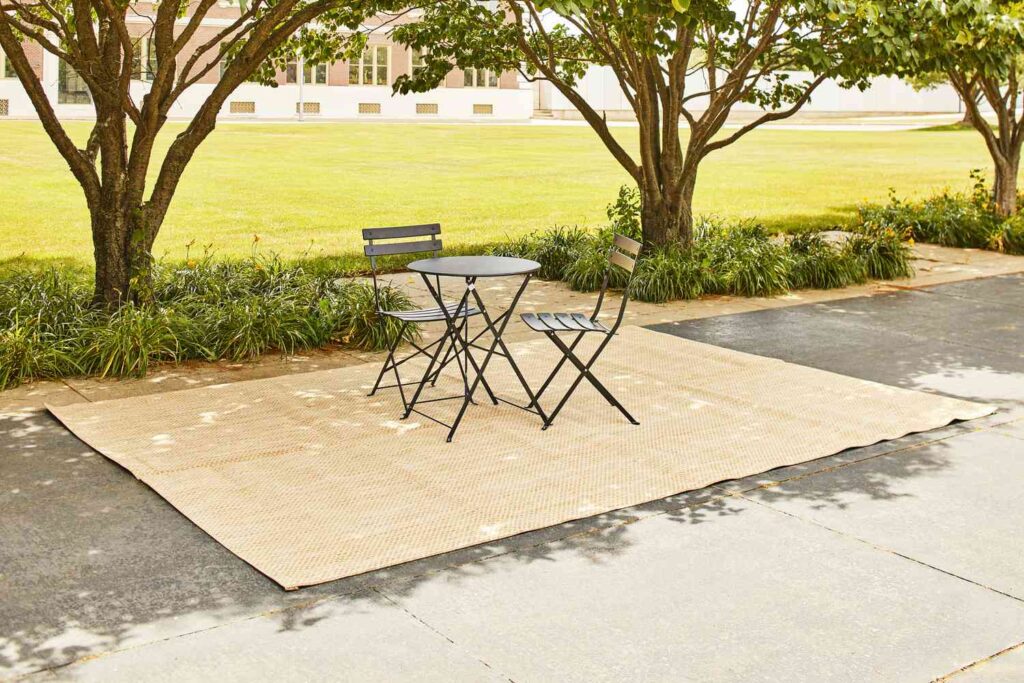
The material you choose for your outdoor rug is just as important as its size and shape. While natural fiber rugs like sisal and jute are durable and add a touch of organic warmth to your space, they may not be ideal for certain environments. For instance, if you live in an area with high humidity levels, natural fiber rugs may be prone to mildew and mold. Similarly, if you live in an area that receives a lot of rainfall, a natural fiber rug may absorb moisture and take longer to dry out.
In such cases, synthetic fibers may be a better choice. Polypropylene, for example, is a popular material for outdoor rugs due to its durability and ability to withstand high traffic and exposure to the elements. It is also resistant to moisture, mildew, and fading, making it a reliable choice for outdoor spaces.
Another advantage of synthetic fiber rugs is their affordability. These rugs are often more budget-friendly than natural fiber alternatives, without compromising on quality or style. Plus, they come in a wide variety of patterns and colors, ranging from understated neutrals to bold geometric designs.
When it comes to selecting the perfect outdoor rug material, it’s important to take into account your unique needs and preferences. Consider the weather patterns in your area, the level of foot traffic your outdoor space receives, and your overall aesthetic vision. With the right material, your outdoor rug will not only enhance the style and comfort of your space but also stand the test of time.
Natural Fiber vs. Synthetic Materials
When it comes to choosing an area rug for your patio or outdoor living space, there are two main options available: natural fibers and synthetic materials. Each comes with its own set of pros and cons, so it’s important to understand the differences between the two before making a decision.
Natural fiber rugs, such as jute, sisal, and seagrass, are made from organic materials and are renowned for their durability and sustainability. These materials are biodegradable and recyclable, making them a great choice for eco-conscious homeowners. Additionally, natural fiber rugs tend to be softer and more comfortable underfoot than synthetic materials.
However, natural fiber rugs do come with some drawbacks. They are more susceptible to moisture and can be prone to staining and fading over time. They also tend to be higher in price than synthetic materials due to their natural origins.
On the other hand, synthetic fiber rugs, such as polypropylene, are man-made and designed to withstand exposure to the elements. They are typically more affordable than natural fiber options and come in a wide variety of patterns and colors, including popular geometric designs.
One of the biggest advantages of synthetic materials is their ability to resist staining, fading, and mildew. This makes them a great choice for high-traffic areas, as well as regions with high humidity and rainfall. They are also easy to clean and maintain, making them a hassle-free option for busy homeowners.
However, synthetic materials can come with some drawbacks as well. They are not biodegradable and may release harmful chemicals into the environment when disposed of. They can also lack the natural warmth and texture of a natural fiber rug.
Ultimately, the choice between natural fiber and synthetic materials comes down to your personal preferences and needs. If you prioritize sustainability and texture, natural fiber may be the way to go. However, if you need something that can withstand heavy use and exposure to the elements, synthetic materials may be the better option. Whatever you decide, investing in a high-quality, well-made rug will help to elevate and enhance your outdoor living space for years to come.
Types of Natural Fibers: Cotton, Jute, and Wool
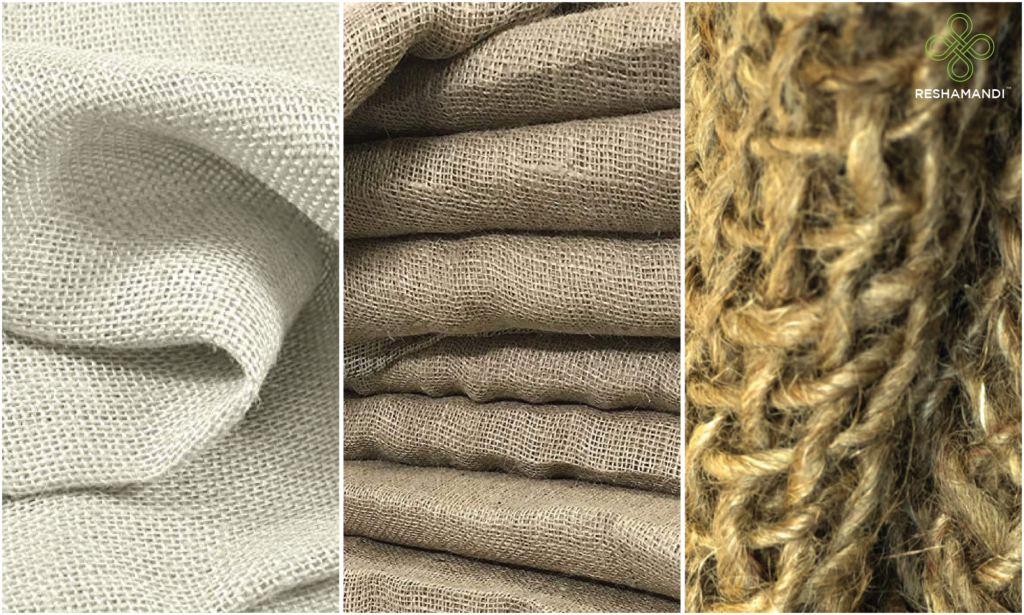
When it comes to choosing a natural fiber rug for your patio or outdoor living space, there are many options available. Three of the most popular natural fiber materials used in outdoor rugs are cotton, jute, and wool.
Cotton rugs are lightweight and soft underfoot, making them a great choice for outdoor seating areas or patios where you want comfort and texture. Cotton is a durable and sustainable material that can withstand foot traffic and weather conditions, although it is more prone to staining and fading than some other natural fibers.
Jute rugs are made from the fibrous plant of the same name, which is known for its toughness and durability. Jute fibers are naturally resistant to moisture and mildew, which makes them ideal for outdoor use. Jute rugs are also known for their natural, earthy tones, which can add warmth and depth to any outdoor space.
Wool rugs are made from the soft fur of sheep, and are often used for indoor spaces as a luxurious and soft option. However, there are also wool rugs designed specifically for outdoor use that offer the same comfort and durability as other natural materials. Wool is naturally resistant to moisture and stains, and is also a great insulator, helping to keep your feet warm on chilly evenings.
When selecting a natural fiber rug for your patio or outdoor living space, it is important to consider the specific needs and style preferences of your space. Cotton, jute, and wool are all great options for outdoor use, and each offer their own unique look and feel. Consider the size of your outdoor area and the seating arrangement when choosing the right size rug, and make sure to select a material and design that fits your personal style and needs. With the right natural fiber rug, you can create a comfortable and inviting outdoor space that you and your guests will love.
Synthetic Fiber Options: Polyester, Nylon and Acrylic
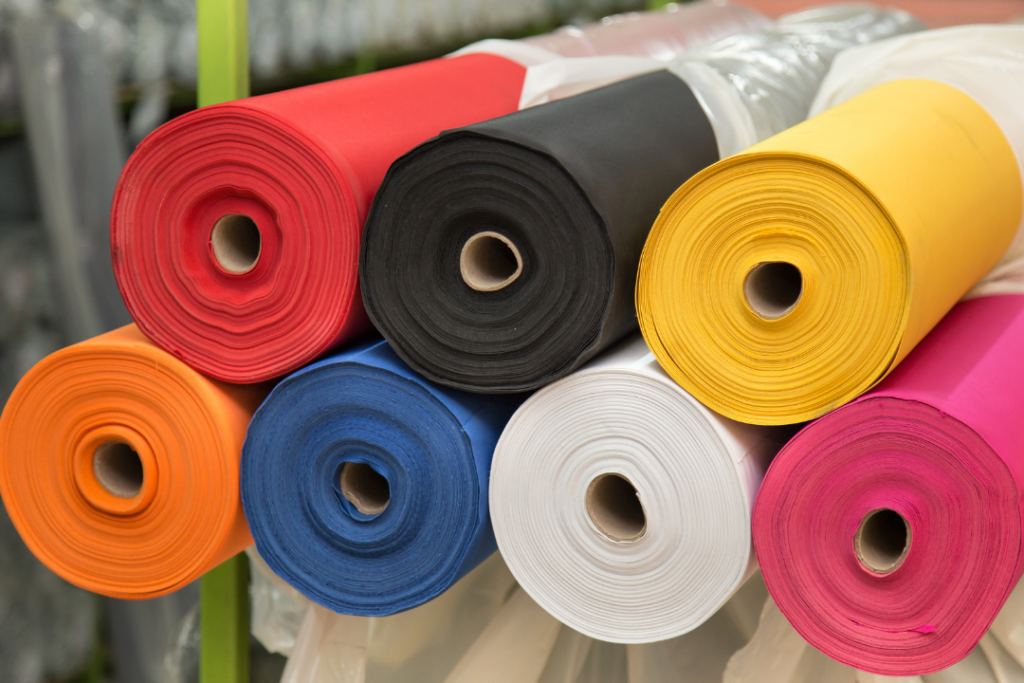
When it comes to outdoor area rugs, synthetic fiber options offer a durable and low-maintenance solution that can withstand the elements. Three popular synthetic materials for outdoor rugs are polyester, nylon, and acrylic.
Polyester is a cost-effective and popular choice for outdoor area rugs. It is easy to clean and dries quickly, making it resistant to mildew and mold. Polyester is also resistant to fading and can withstand harsh UV rays, ensuring that your rug retains its color for a long time. It is important to note, however, that polyester may not be as durable as other synthetic materials and may be prone to wear in high traffic outdoor areas.
Nylon is a strong and long-lasting material that is perfect for outdoor rugs. It is resistant to staining and fading and can easily withstand heavy foot traffic. Nylon is also known for its resilience, allowing it to maintain its shape even in high traffic areas. This material is highly durable, and its resistance to fading makes it a great choice for sunny patios or outdoor dining areas.
Acrylic is a versatile and scratch-resistant material that is perfect for outdoor rugs. It can mimic the look and feel of natural fibers while being more durable and stain-resistant. Acrylic is also resistant to UV rays, contributing to its long-lasting color. It is a great material for outdoor living spaces as it can withstand a lot of foot traffic and is easy to clean.
In terms of cost, polyester rugs may be the most affordable, while nylon and acrylic can be pricier due to their high durability and resistance to staining and fading. However, investing in a high-quality synthetic fiber rug can save you money in the long run by reducing the need for maintenance or replacement.
When choosing a synthetic fiber for your outdoor rug, consider the specific needs of your space and lifestyle. Polyester, nylon, or acrylic are all great options that offer different benefits, making it easier to find the perfect rug for your outdoor living area.
Geometric Patterns & Colors

Geometric patterns and colors have become increasingly popular in interior and fashion design in recent years. These patterns can add a modern touch to any space or outfit and come in a variety of shapes, sizes, and colors.
Geometric patterns, which are characterized by lines and shapes, can be used in a variety of ways in design. A popular way to incorporate these patterns is through rugs and textiles. From hexagons to triangles to diamonds, geometric shapes can be seen in a variety of rug designs. Adding a rug with a geometric pattern can bring a pop of color and interest to a room while still maintaining a modern aesthetic.
Geometric patterns are also popular in wall art and wallpaper design. A bold, graphic wallpaper with a repeating geometric pattern can make a statement in any space. Additionally, geometric shapes can be added to accessories such as throw pillows and vases to tie in the design throughout the room without overwhelming the space.
When it comes to color, geometric patterns can be found in nearly any color scheme. Bright, bold colors such as reds, blues, and yellows can make a statement in a room and show off the modernity of the pattern. Neutrals such as black and white or gray can be used to tone down the pattern while still maintaining the modern aesthetic.
Color blocking is another popular way to use geometric shapes in design. By using bold, contrasting colors in a defined geometric shape, a room can take on a contemporary feel. For example, a sofa with a bright, geometric patterned cushion against a solid-colored wall can create a striking contrast.
In fashion, geometric patterns can be seen in a variety of clothing styles and accessories. From statement jewelry to patterned pants, geometric shapes can add a modern touch to any outfit. Like in interior design, bright, bold colors can make a statement in fashion while neutral colors can be used to tone down the pattern.
Overall, geometric patterns and colors are a popular design choice for adding a modern touch to any space or outfit. From rugs to wallpaper to accessories, these patterns can be used in a variety of ways to create a bold statement or a subtle modern touch.
Color Considerations
When it comes to decorating your home, choosing the right colors can make all the difference. It can set the mood, create a sense of harmony, and reflect your personality. Here are some things to consider when choosing colors for your home:
1. Mood: Colors can have a powerful impact on your mood, so think about what kind of atmosphere you want to create in each room. Warm colors like red, orange, and yellow can create a cozy and inviting atmosphere, while cool colors like blue, green, and purple can create a calm and serene environment.
2. Lighting: The amount and type of lighting in a room can also affect how colors are perceived. Natural light shows colors in their truest form, while artificial light can change how colors appear. Take note of the lighting in each room before selecting colors.
3. Size of the Room: The size of the room can also impact color choices. For small rooms, lighter colors can make the space feel more open and larger, while darker tones can make it feel cramped. In larger rooms, bolder and darker colors can be used to make a statement without overwhelming the space.
4. Cohesion: Consider choosing colors that work well together throughout the entire house. This creates a sense of harmony and cohesiveness, making each room feel connected without being too matchy-matchy.
5. Personal Taste: Ultimately, your personal taste and style should be taken into consideration when choosing colors for your home. If you love bright and bold colors, incorporate them in a way that makes you happy and comfortable. Likewise, if you prefer a more muted palette, stick with what you love and create a space that reflects your personality and style.
Remember, the colors you choose for your home should make you feel happy, comfortable and create a space that you love to come home to. By considering these factors, you can select the perfect palette to create a comfortable and inviting home that reflects your unique style and personality.
Geometric Designs & Patterns

Geometric designs and patterns have been used in art, architecture, and fashion for centuries. These designs are based on various shapes, lines, and angles, such as triangles, squares, circles, and hexagons. Geometric designs can range from simple and minimalistic to complex and intricate.
One of the reasons why geometric designs are popular is because of their versatility. They are a great way to add visual interest and depth to any space or outfit. For example, a geometric patterned rug can instantly add a pop of color and texture to a room, while a geometric print dress can make a bold statement at a party or event.
Another advantage of geometric designs is that they can complement any style. Whether you prefer modern and minimalist décor or a more traditional look, there is a geometric pattern that can work for you. For example, a black and white geometric pattern would look great in a modern space, while a colorful Aztec-inspired geometric pattern would fit in with a bohemian theme.
Geometric designs can also be used to create a sense of organization and balance. By repeating patterns and shapes, a room or outfit can have a cohesive and balanced feel. And with so many different types of geometric designs, you can choose a pattern that reflects your personality or taste.
Lastly, geometric designs are timeless. They have been used in various cultures and time periods throughout history, and continue to be popular today. So investing in a piece with a geometric design or pattern is a great way to ensure that it will never go out of style.
In conclusion, geometric designs and patterns offer endless possibilities for creativity and self-expression. Whether used in art, architecture, or fashion, they can add visual interest, organization, and balance to any space or outfit. So why not embrace the geometric trend and add a little bit of fun and flair to your life?
Seating Arrangements & Furniture Placement
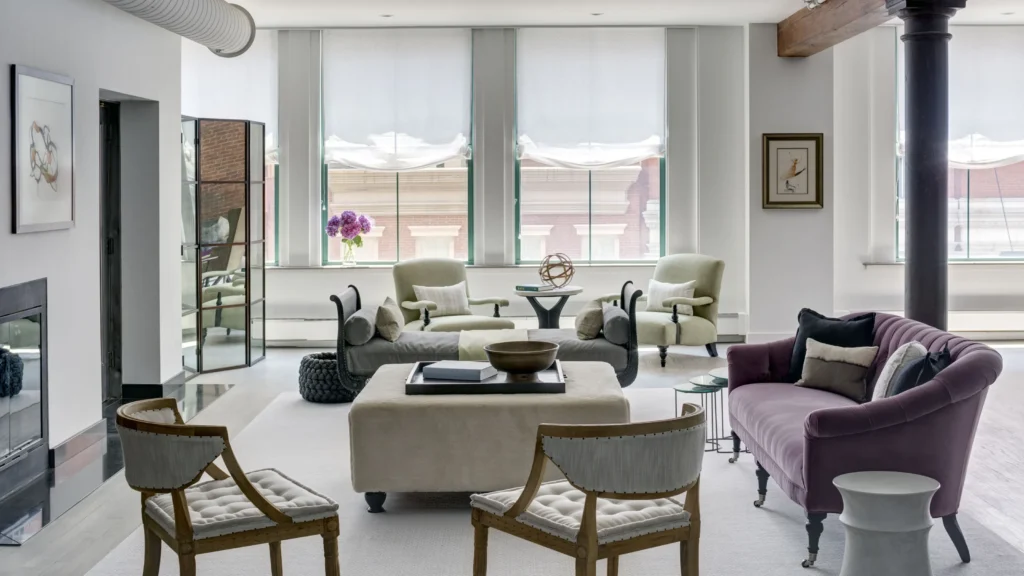
When it comes to designing any room, one of the biggest factors to consider is the seating arrangements and furniture placement. This can affect the flow, functionality, and overall feel of the room.
One key consideration is the size and shape of the room. For larger spaces, creating multiple seating areas can help to break up the space and make it feel cozier. For example, a living room with a large sectional sofa can be complemented by a pair of chairs in the corner or an additional seating area by the fireplace. On the other hand, for smaller spaces, it’s important to maximize the use of the area without overcrowding it. Choosing smaller furniture pieces, such as armless chairs or a loveseat, can help to conserve space and create a more intimate feel.
Another consideration is the purpose of the room. For example, in a dining room or kitchen, having a table and chairs that are appropriately sized for the space is crucial. A table that is too large can be overwhelming, while a table that is too small can feel cramped. Additionally, in a space where guests will be seated for extended periods of time, comfort is key. Consider chairs with upholstered seats or cushions that provide adequate padding, versus wooden chairs that may become uncomfortable over time.
Furniture placement can also affect the overall aesthetic of the room. Placing furniture in symmetrical arrangements can create a sense of harmony and balance. This can be achieved by placing identical chairs or tables on either side of a sofa or fireplace, for example. On the other hand, asymmetrical arrangements can create visual interest and add a touch of eclectic style to the room.
Ultimately, the key to successful seating arrangements and furniture placement is finding the right balance between function and form. By taking into account the size, purpose, and aesthetic of the room, you can create a space that is both comfortable and stylish.

